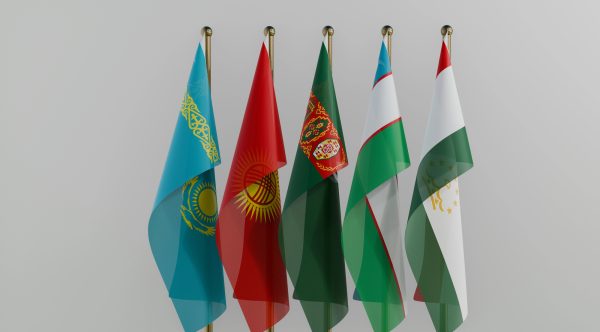By Eric Rudenshiold
Copyright thediplomat

Foreign policy experts prefer continuity to change, stability to volatility, the familiar to the unknown. International relations scholarship reinforces this preference by clinging to established archetypes: balance of power, spheres of influence, and the seemingly self-evident axiom that small states are inevitably pawns in the struggles between great powers. Few regions are so habitually pigeonholed as Central Asia. Since independence, Kazakhstan, Kyrgyzstan, Tajikistan, Turkmenistan, and Uzbekistan have been cast in Washington, Brussels, Moscow, and Beijing alike as vulnerable prizes in a “new Great Game,” more acted upon than acting. Persisting in antiquated assumptions risks missing not only the newfound agency of the Central Asian states themselves, but also the opportunities their assertiveness creates for Western allies. These countries increasingly define themselves as “middle powers” – actors with enough weight, resources, and diplomatic creativity to resist Russian or Chinese domination, to negotiate with multiple players, and to pursue independent development strategies. Nowhere is this more apparent than Central Asia’s reaction to Russia’s aggression toward Ukraine. Not cowed into deference, Central Asia is instead accelerating a realignment that is diversifying the region away from the limitations of Soviet legacy infrastructure and Russia’s market stranglehold. Moscow’s border treaty abrogation and invasion of Ukraine compelled Central Asian leaders to reinvest in their self-styled concept of “multivectorism” by engaging simultaneously with multiple partners and not subordinating themselves to the interests of large neighbors. This pursuit of sovereignty and regional integration is exemplified in the region’s organic creation of a “Middle Corridor” trade route that redirects freight away from Russian infrastructure and connects Central Asia to China in the east and Europe via the Caspian, the South Caucasus, and Turkiye to the west. Supporting this shift is not just an economic matter but a geopolitical imperative: it is the surest way to reduce Russia’s coercive tendencies, to blunt China’s monopolization of connectivity, and to secure a more prosperous and independent Eurasia. History’s Outdated Lens The 19th-century Great Game between the Russian and British empires remains a convenient scholarly shorthand for observing Central Asia, but that perspective reduces the region to an arena of contest rather than what has become a community of states working to develop its own capacity to maneuver in a complex geopolitical space. In the post-Cold War era, outside powers have tended to define the region’s trajectory as fated and subservient to Russia’s Soviet legacy and sphere of influence, China’s Belt and Road Initiative, and vulnerability to terrorist caliphates. Such views overlook and discount the possibility that Central Asian leaders themselves could balance, hedge, or innovate in pursuit of sovereignty when opportunity presented itself. Russia’s preoccupation with Ukraine has provided the region with the impetus for a more independent course of action and a regional coming of age. Today the five Central Asian states are increasingly acting as a “C5” bloc, assuming a crossroads mentality that harkens back to their ancient Silk Road roots of doing business with all comers. Seeking to become a hub with diversified and expanded connectivity, the region is engaging a multiplicity of partners without any required alignment and defying the neat categories of East versus West. Doing business for Central Asia’s capitals is not a zero-sum undertaking with either one neighbor or the other, but a growing expression of outreach, cooperation, and economic sovereignty that breaks traditional barriers. Seen this way, the region is not a prize in a renewed Great Game but an axis for multivector diplomacy and commerce in an era where the C5 middle powers are leveraging their geography to conduct business on their own terms – not those dictated by their neighbors. The ability of Central Asians to cooperate within C5 formats, to coordinate on issues like water, trade, and digitalization, and to invite multiple external partners into carefully bounded sectors illustrates that agency. The Invasion That Changed the Rules For Central Asia, Russia’s first invasion of Ukraine in 2014 was a shock, but not yet a rupture. The violation of Ukrainian sovereignty undermined Moscow’s commitments from the 1991 Alma-Ata Declaration, in which all post-Soviet states pledged to respect one another’s territorial integrity. That foundational commitment had been a keystone for interstate relations between the newly independent republics and for them to accept Russia as a partner in a “civilized divorce” from the Soviet empire. If Moscow could renege on that, what else might it discard? The answer came in February 2022, when Russia launched a massive second invasion of Ukraine. Moscow’s subsequent demands that Central Asian governments support its annexations or send troops were met with refusals. None has recognized Russia’s territorial claims in Ukraine. Kazakhstan’s President Kassym-Jomart Tokayev made a show of defiance, reaffirming his country’s sovereignty and directing his officials to coordinate with Western governments to prevent Russian sanctions evasion and to avoid possible secondary sanctions. The message was unmistakable: Moscow’s capacity to command deference from Central Asia was waning. The war’s economic consequences underscored the urgency of diversification. Western sanctions on Russia ricocheted through Central Asia, closing access to traditional markets in and through Russia, restricting banking and finance systems largely controlled by Moscow, as well as ceasing use of Russian transportation networks that had long been the region’s economic lifeline. Yet sanctions also created incentives. Faced with the risk of secondary sanctions, Central Asian states began to scale back dependence on Russia, while simultaneously searching for new avenues of trade. Multivectorism Reborn The desire to realign relations with its neighbors is not new. Kazakhstan’s President Nursultan Nazarbayev pioneered “multivectorism” in the 2000s to balance ties with Russia, China, the United States, and Europe, and as a means of securing sovereignty. Uzbekistan under current President Shavkat Mirziyoyev also embraced the concept, working to build positive relations among Central Asian countries. For decades, multivectorism was less a genuine strategy than a polite fiction. Moscow’s legacy infrastructure – pipelines, rail lines, electricity grids – ensured that any real diversification remained limited, while China’s entry into the region via the Belt and Road Initiative (BRI) added a new layer of dependence and need for counterbalancing mechanisms. However, the region’s external relations have changed dramatically. The war in Ukraine, combined with sanctions pressure, catalyzed a search for alternative trading partners and business relations. New cooperative mechanisms were adopted to speed trade, expanded capacity was added at Baku’s Alat Port, and multidonor investments were made in rail links through Azerbaijan, Georgia, and Turkiye. These efforts have transformed the Middle Corridor from a theoretical route into a viable economic gateway. In 2021, trans-Caspian trade volume was a scant 586,000 tons; by 2024, it mushroomed to over 4 million tons for year-on-year growth of over 60 percent. Remarkably, this change is an organic process where Central Asian states are for the first time investing in one another, pursuing collective diplomacy and joint projects that would have been unthinkable even five years ago. Regular presidential summits, initiatives for once-unthinkable cooperation on sensitive issues like regional water and energy, and coordinated outreach to international partners, all reflect a new energy and sense of collective agency. In effect, Central Asia is learning to act as a bloc – not against great powers, but on its own terms with them. Moscow Shrinks and China Swells Russia has not accepted this shift quietly. Moscow retaliated with a standard arsenal of hybrid tactics: throttling oil exports from Kazakhstan, striking Azerbaijani infrastructure that supports Central Asia’s energy transit, and spreading disinformation and stoking hostility toward Central Asian migrant workers inside Russia. But the impact of such intimidation is diminishing. In the 1990s and 2000s, even the threat of Moscow’s displeasure was often sufficient to curb thoughts of straying from Russia’s sphere of control. Today, these threats generate open resentment and encourage further diversification. Ironically, the more aggressively Russia uses its hybrid tools, the more rapidly Central Asian states work to find alternatives. In a continued hat tip to great power thinking, staid Western analysis of Central Asia presumes that if these states loosen ties with Moscow they must inevitably then fall under Beijing’s sway. China is the region’s largest trading partner, a leading investor, and the source of much infrastructure financing and construction. Yet, to assume that Central Asia will simply exchange a master in Moscow for one in Beijing is to miss the essence of multivectorism. Central Asian capitals do not wish to be sucked into China’s orbit any more than Russia’s. They value Beijing’s capital and markets but are wary of debt dependence and potential strings attached to BRI projects. Their strategy is not alignment but diversification – leveraging China where it suits them, balancing it with ties to Europe, Turkiye, the Gulf, and, increasingly, the United States. The Middle Corridor is critical to achieving such an equilibrium. By providing access to Europe without reliance on Russia, the Middle Corridor strengthens the region’s negotiating position. Moscow has tended to see economic relations in zero-sum terms that have not favored Russia’s partners. For Central Asia, the more its corridor grows, the less dependent the region is to any single external power or infrastructure system. The South Caucasus However, the utility of the Middle Corridor hinges on stability in the South Caucasus. Here, too, old frameworks are shifting. For decades, Armenia and Azerbaijan were locked in a frozen conflict over the Nagorno-Karabakh region, a standoff that Moscow exploited to maintain leverage over both. The recent peace process, fragile though it may be, creates new possibilities and options. The reconciliation between Yerevan and Baku will enable Armenia to join the Middle Corridor, open its closed borders, and establish trade connectivity with Turkiye and Europe via a reconstructed Soviet-era rail line that could more than double the Middle Corridor’s freight capacity. For Azerbaijan, this expansion would further solidify its own role as a regional hub between Central Asia and Europe, reinforcing energy and trade ambitions. The peace process dovetails with Central Asia’s broader strategy of emancipation – reshaping regional connectivity in ways that sideline Russia’s role as the indispensable intermediary. For the West, the evolution of Central Asia from pawn to middle power has direct implications for global security and economic stability. A more sovereign Central Asia is less susceptible to Russian coercion, reducing Moscow’s capacity to weaponize energy and infrastructure against its neighbors. Diversified connectivity weakens China’s near-monopoly on Eurasian infrastructure, providing alternatives that benefit Europe and Asia alike. Finally, supporting Central Asia’s autonomy enhances resilience against potential extremist spillovers from Afghanistan, strengthening a region whose stability affects Europe, South Asia, and the Middle East. Above all, engagement with Central Asia on its own terms offers the West an opportunity to demonstrate that Western support is not conditional on alignment against China or Russia but rooted in respect for sovereignty and choice which is precisely what the region seeks. This style of deferential engagement was the underpinning of Central Asia policy in the first Trump administration. Supporting the Middle Corridor and Middle Powers Western partners have an opportunity to invest in Central Asia as a new hub and to make the Middle Corridor a strategic priority. That means investing in infrastructure, providing financing guarantees, supporting customs and regulatory harmonization, and facilitating digital and energy interconnections. It also means diplomatic support for the Armenia-Azerbaijan peace process, without which the corridor cannot reach its full potential. Beyond the trade route, engagement should emphasize capacity building, strategic mineral development, technology partnerships, and areas where the West offers value distinct from Russia and China. Cooperation should be framed not as competition among great powers, but as support for and reinforcement of Central Asia’s own economic and geopolitical independence. The task for Western policymakers is not to prevent some inevitable drift into another camp but to recognize and reinforce the region’s growing agency, helping create conditions where multi-vector strategies are sustainable rather than fragile. For too long, analysts have persisted in seeing Central Asian countries as weak players amid great power rivalry. That description no longer fits. The Central Asian states are developing new connectivity and forging collective strategies that weaken Moscow’s grip and complicate Beijing’s dominance. They are, in short, actually behaving as middle powers, choosing autonomy over dependence, pursuing sovereignty not as aspiration but as a matter of practice. Western policymakers should engage at this pivotal moment, investing in critical areas that underpin sovereignty and independence. The reward is substantial – a more stable, secure, and resilient Central Asia, connected globally and less vulnerable to coercion by any single power. Russia’s hybrid war is faltering and China’s dominance is not inevitable. The Middle Corridor, and the regional agency it represents, is the key to a new Eurasian order.



